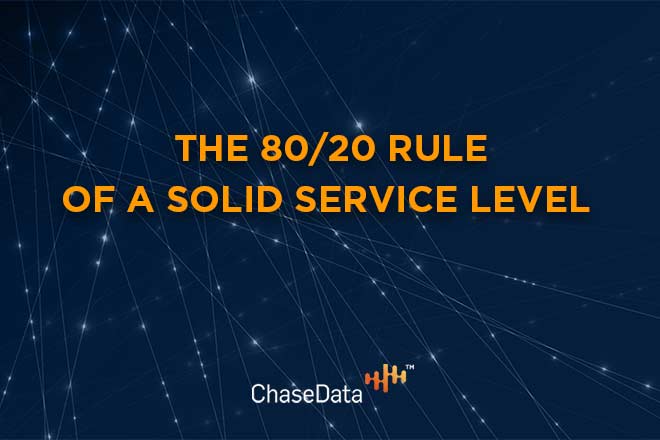March, 4 2020 12:29 pm

What is the formula for a good call center service level? Many experts would argue that there isn’t one standard equation that fits every scenario, and they’re right; your facility is as unique as the agents who comprise your team and the consumers you serve. However, there is a formula that many successful centers use to create a successful plan for rendering service at their best possible level - and your center could likely make great use of it, too.
The 80/20 rule - breaking down to 80% of call or more being answered within 20 seconds or less - is a great start for building a successful call center. Why? Because consumers today want their concerns addressed quickly. If you’re shooting for a solid service level, there’s no better start than with the golden rule of 80/20. Here’s more about why:
While the 80/20 rule is seen as the gold standard of service level, it leaves some industry experts rattled.
Part of the reason is because no one knows where it came from - there is no official record of who chose this ratio. However, it has worked for so long and looks to continue to do so, so it’s unlikely to fall out of fashion any time soon. After all, if it’s not broken, why fix it?
The 80/20 service level target is the most common for a reason - it works well. However, it is far from the only target in use. Many of today’s more ambitious call centers look to variations, anywhere from 50/40 to 100/180. This wide range means that how customers are served by various centers can be personalized almost entirely to tailor service to the center’s individual demographic.
Why cover this here? It is important to understand and remember that the 80/20 rule is not the only service level goal which can be used. There is plenty of room for variation - and that wiggle room should be used to create a goal that works for your center. Never feel as if you have to abide by some kind of industry standard if it doesn’t work for your team and facility. Make the goal work for you, rather than the other way around.
So, with so much variation in the industry, you might be wondering what other companies have against this widely-accepted industry standard service level goal. The truth is, more and more centers are taking longer on the phone, which means they may also be relaxing their average speed of answer target goals.
How does that work with the fast-paced, time-sensitive world of contact centers? That world, just like everything else in the realm of customer service today, is changing. Part of that change is to allow for longer, more comprehensive service calls to better serve consumers. Consumers are almost guaranteed to rate their experience as more positive when they enjoy longer calls, since these calls are typically more personalized and more focused on their actual needs, than simply meeting target time goals.
What about the obvious issues that longer calls and longer waits will cause? Chief among these is abandonment rate, which can result from consumers being left on hold for too long. Long hold times are a reality of this longer call format. However, there is an equally obvious solution that can keep your customers from lingering in undue waits and can also keep you from having to overstaff your center to address the problem.
That solution is the callback. Simply offer your consumer the option to be called back when an agent becomes available. This saves them time and saves your center money, and you;ll be surprised at how many customers are delighted to have this option.
There are also some costs savings that should be mentioned when it comes to deserting the 80/20 rule. Longer calls means fewer calls to answer over all, which means fewer agents on the clock. This difference shouldn’t be major; too few calls and your business would suffer, after all. However, the difference is likely to be noticeable enough that you can realize some labor cost savings from it. Take advantage of those savings if you choose to skip the 80/20 rule.
If there is such a strong case against using the 80/20 rule as a hard and fast target, why do so many people still use it? Is it still useful for your center?
That answer depends largely on the needs of your center, but there are many reasons so many facilities still lean on this rule: it works. Aiming to answer 80% - the large majority - of your calls within 20 seconds puts those calls being answered in a time frame that has been shown to greatly decrease call abandonment. That means that if you’re shooting for this target, you’re likely to decrease the instance of consumers hanging up in frustration - and greatly increasing the number of calls that will actually be handled by your agents.
No matter what service level target you choose - or even if you don’t have a hard and fast number - it is important to remember that these goals are just that: goals. They are designed to help your agents visualize success, not created as a means of punishing them for falling short. Even if you shoot for 80/20 and fail, it’s no failure. A number close to that is still a solid service level. Remember to celebrate it along the way to improvement!
Ready to take your service level through the roof? At ChaseData, we offer the tools and technology your team needs to do exactly that. Trust our software solutions to help you make the most of every minute your agents are on the clock - and get more calls answered in less time, without feeling overwhelmed. Want to learn more? Give us a call today!